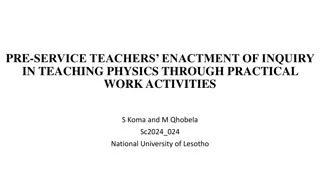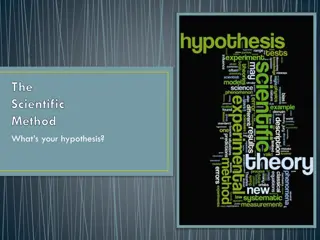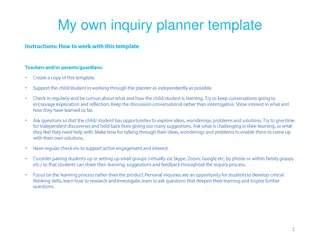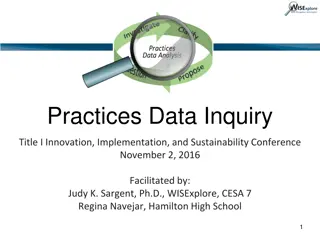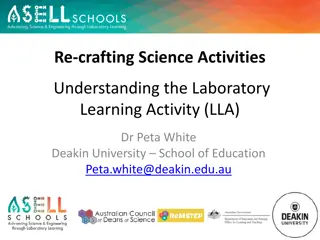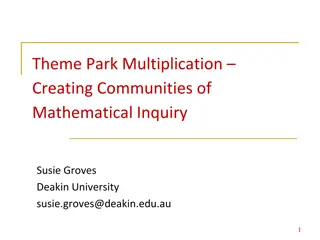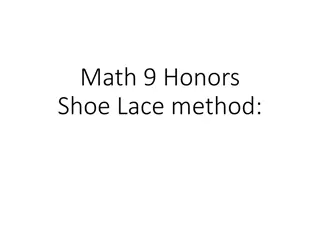Aligning Inquiry Approach, Design, and Method
Explore the concepts of Approach, Design, and Method in scholarly inquiry, debunk common misconceptions, and understand various research designs for implementing a successful inquiry process.
Download Presentation

Please find below an Image/Link to download the presentation.
The content on the website is provided AS IS for your information and personal use only. It may not be sold, licensed, or shared on other websites without obtaining consent from the author.If you encounter any issues during the download, it is possible that the publisher has removed the file from their server.
You are allowed to download the files provided on this website for personal or commercial use, subject to the condition that they are used lawfully. All files are the property of their respective owners.
The content on the website is provided AS IS for your information and personal use only. It may not be sold, licensed, or shared on other websites without obtaining consent from the author.
E N D
Presentation Transcript
2016 L9:Big Idea 1-Question and Explore-Aligning the Inquiry Approach, Design, and Method
2016 Lesson 9: Learning Goal Learning Objective 1.5B: Designing, planning, and implementing a scholarly inquiry. 2
2016 Lesson 9: Focus Describe what you think is meant by the following terms as they pertain to a student s inquiry: Approach Design Method Revise your definitions after the lesson if necessary. 3
2016 L9: Teach
2016 Misconception Alert #1 You may think you need to be an expert in every discipline-specific method of inquiry. This is not true. You simply need to be able to access information, sources and evidence to help you choose or develop an aligned method of inquiry to collect and analyze data appropriate to the field of your topic of inquiry. You also need to be able to use other s studies and evidence (within the discipline) to provide rationale for your choices. 5
2016 Misconception Alert #2 You may think that good research collects only primary data. This is not true. Many great studies or meta-studies collect secondary data/information and add their own interpretation to that data in a new context, which is a valid form of research. 6
2016 Approach: Exploratory, Explanatory, or Create Explore a phenomenon/event/thing and look for themes, variables, and trends (this usually takes place when variables, trends, and/or themes are not known or not well understood). Explain connections between and patterns within phenomena, events, variables (this usually takes place when variables about a phenomena are known but the connections between them are not). Create or design a solution to a problem (this could be a new understanding under explore or explain but in this sense, its meant too be a process, design, or additional piece of scholarly work as a result of the research). 7
2016 Design: Experimental or Non- experimental Experimental Design usually involves pre-test, post-test, identifying correlations between variables, random assignment, control groups etc. Non experimental Design does not include a large measure of control and is usually assigned to case studies, interviews, and largely qualitative studies (although some qualitative studies may be highly experimental). Regardless, both designs must be explicit and clear so as to be reproducible. 8
2016 Research Method: Qualitative, Quantitative, or Mixed Qualitative, quantitative, or mixed methods are explicit in: what data/information is collected Primary Secondary Text, numbers, images, etc. how data/information is collected how data/information is interpreted/analyzed 9
2016 When in Doubt, Check the Course and Exam Description EK 1.5 B5-provides general descriptions of qualitative and quantitative methods. Students don t have to memorize these methods. Students MUST know how to choose which method to govern their research and provide effective rationale for why that method is appropriate/aligned as opposed to others. 11
2016 Comparing Qualitative and Quantitative Purposes Quantitative Qualitative Focus is on objectivity Explanatory Focus is on interpretation Descriptive/Exploratory Data is counted/measured (i.e. uses numbers). It tends to come from lots of people. Data is descriptive often textual. It tends to focus on a specific case or cases. Open and flexible data categories emerge through the process. Pre-organised data categories Focus on facts and the relationship between one set of facts and another Focus on meanings Aims to find generalizable conclusions Aims to find insights into particular contexts 12
2016 Comparing Data Collection Methods Quantitative research methods include: Surveys Laboratory experiments Questionnaires Qualitative research methods include: Case study research - a case study is an empirical enquiry that investigates a contemporary phenomenon within its real-life context Ethnography- the ethnographer immerses her/himself in the life of people s/he studies and seeks to place the phenomena studied in its social and cultural context Observations Interviews Focus Groups 13
Differences in Qualitative and Quantitative Analysis and Reporting Methods 2016 Components Qualitative Reporting/Analyses Quantitative Reporting/Analyses numbers Variables, statistical coefficients Data Type Emphasized Categorization of data narrative, text Coded themes Condensed presentation of data Rationale Narrative examples Graphs, charts, data tables Claims supported with contextual and narrative data Inductive Claims supported with statistical data Deductive Logical pathway to conclusion Acknowledges Limits Emphasis on bias, perspective, triangulation Build a picture with rich triangulated data sources (Neuman, 2011). Emphasis on correlation and measurement validity Identify the strength of an assumed pattern within the big picture with statistical data General approach 14
2016 Primary and Secondary Research Primary Research Secondary Research Primary research involves collecting data through fieldwork, trials or experiments Secondary research synthesizes existing research. Advantages Disadvantages Advantages Disadvantages Researcher can focus on both qualitative and quantitative issues Can be very expensive in preparing and carrying out the research Somebody has done all the legwork for you Establishing credibility may be an issue Addresses specific research issues Requires the development and execution of a research plan Others may have more resources at their disposal than you Is it up to date? Researcher controls the design to fit their needs It takes longer to undertake primary research than to acquire secondary data There is usually greater variety to choose from Is it a fair representation? Greater control of issues such as size of project, time frame, and goal Low response rate has to be expected It is usually quicker to find It might not be an exact fit for your purpose 15
2016 Example (Purpose, Data Collection, Data Analysis) Amount of orange juice consumed associated with number of times you smiled in the morning (survey 900 people) versus Your explanation of how you felt in the morning associated with what you ate (interview 20 people) 16
2016 L9: Practice I
2016 Aligning Approach, Design, and Method in the Inquiry Process 1. After reviewing the different types of research approaches, designs, and general methods with your instructor, look at the Research Methods in a Nutshell table. 2. Use the description of the various methods to complete the data table below by indicating the approach, design, method, and type of data typically associated with each type of inquiry process. 18
Inquiry Process Approach Design Method Primary/Secondary Data 2016 Explore/Explain/Create Exp/non-exp Qnt., Qlt., Mxd. 1, 2, both Case Study research Causal comparative research Content analysis Correlational research Descriptive research Ethnographic Experimental research Grounded Theory Hermeneutic research Historical research Meta analysis research Narrative research Phenomenology Quasi experimental 19 True Experimental research
Inquiry Process Approach Design Method Primary/Secondary Data Explore/Explain/Create Explore Exp/non-exp Non-Experimental Qnt., Qlt., Mxd. Qualitative 1, 2, both Usually 1 Case Study research Causal comparative research Explain Non-Experimental Quantitative or Mixed both Content analysis Correlational research Explore Explore/Explain Non-Experimental Non-Experimental Qualitative Quantitative both both Descriptive research Explore Non-Experimental Qualitative both Ethnographic Experimental research Explore Explain Non-Experimental Experimental Qualitative Quantitative or Mixed Usually 1 Usually 1 Grounded Theory Hermeneutic research Explore/Explain Explore Non-Experimental Non-Experimental Qualitative Qualitative both Usually 2 , sometimes both Historical research Explore Non-Experimental Qualitative Usually 2 , sometimes both Meta analysis research Explore/Explain Non-Experimental Qualitative/Quantitative/Mixed Usually 2 Narrative research Explore Non-Experimental Qualitative Usually 1 Phenomenology Quasi experimental Explore Explore/Explain Non-Experimental Experimental Qualitative Quantitative/Mixed Usually 1 Usually 1 True Experimental research Explain Experimental Quantitative Usually 1 20
2016 Decision Tree for Methods Research Question Qualitative (usually) Purpose: Explore Non Experimental Aesthetic/Engineer Processes Workshopping, storyboarding, etc. Purpose: Create Quant/Mixed (usually) Purpose: Explain Experimental 21
2016 L9: Practice II
2016 The Importance of Alignment The purpose (approach) of the inquiry is the basis for the research question. The narrow context/variables/scope of the research question as well as the purpose (approach) of the inquiry should point to the design of the inquiry process. Finally, the design of the inquiry process provides the foundation needed for the students to choose and then implement an aligned method. If any of these components are misaligned, it may be very difficult for the reader to interpret a researcher s results and could even hamper the validity of the research as well as the credibility of the researcher. 23
2016 Case and Point If the purpose of the inquiry is to explore the variables and themes within a phenomenon and the design is experimental requiring a pre-test and post test of unknown variables, the research will ultimately fail (seeing as the variables to be tested are not even known to exist). If the purpose of the inquiry is to create a new design or process yet the researcher wants to explain whether or not the new process/design was effective as an intervention students need to know this is misaligned. An intervention strategy is an explain purpose with an experimental design. 24
2016 Check Your Alignment Your instructor will assign you one of the excerpts below. Use your assigned excerpt (1 4) to identify the research question, approach, design, and method. Evaluate the extent to which the excerpt presents an aligned research question, approach, design, and method. Use the questions below to guide your evaluation: 1. Is the method clearly articulated? (Provide evidence.) 2. Is the method congruent/aligned with the approach inherent in the research question? (Provide rationale.) 3. Is the design aligned to the research question, approach, and method? (Provide evidence.) 4. What if any components are not clear or are missing from the excerpt in reference to: a. a well-formed, focused research question; b. a clearly articulated method for collecting data/information to answer the research question; and c. an aligned approach, design, and method to the research question/purpose of the study 25
2016 L9: Reflect
2016 Reflection-Include your response in your workbook. What criteria or rules will you use to determine whether or not the method you designed or chose for your research is aligned with the purpose of your question? Where can you look to get ideas about aligned research methods to help you choose or develop your own? 27



